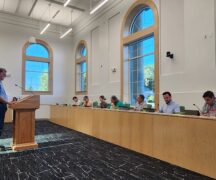Local governments in Ohio and throughout the United States are facing significant challenges regarding the resiliency of energy and water supplies, and the threats of climate-caused natural disasters such as floods, droughts, tornadoes, winter storms and heat waves. The recent report, Bowling Green Climate Action and Resiliency Improvement Plan, is an important first step in describing the problems and proposing options regarding how to address these issues.
A Climate Action Plan is focused on Bowling Green’s electricity and other energy sources, the extent that those energy sources cause greenhouse gas (GHG) emissions, and the options available to achieve national goals of net zero carbon emissions. As the report specifies, net zero carbon emissions cannot be achieved solely by moving to renewable energy sources (wind, solar, hydroelectric, landfill natural gas) partially because of the need for baseload electricity (electricity that is always available, unlike wind and solar) and also because of the need for peaking and emergency power which requires standby generators that can be activated quickly (typically natural gas, although battery storage units are increasingly filling this role). As a result, the national goal and mandate of net zero carbon emissions will be achieved through a combined strategy involving shifting to renewable energy resources but also through energy conservation efforts and through carbon offsets. These are detailed in the report.
A Resiliency Improvement Plan is all about environmental hazards to Bowling Green due to extreme weather, which is being augmented (increasing frequency and magnitude) by climate change. In Bowling Green, those hazards are floods, droughts, tornadoes, winter storms, and heat waves. A particular threat to Bowling Green is the vulnerability of our water supply (the Maumee River) due to extended drought. A repeat of the decadal drought of the 1930s would result in a water crisis for our community. Threats to property damage are most severe from flooding and tornadoes. The historical flood of 1913 was a 500-year flood that had the following impact on Ohio: 467 people killed, 34000 houses destroyed, 220 bridges washed out, and $4.5 billion in damages. Regarding tornadoes, there have been 95 tornadoes within 50-miles of Bowling Green since 1950, including four EF4 tornadoes (winds up to 200 mph). The greatest threat to human lives is either a tornado or a combination of a heat wave and power failure. In July 1936 Bowling Green experienced 8 consecutive days of greater than 103oF, peaking at 115oF. A recurrence of this heat wave combined with a power failure due to excessive electricity demands (which has happened in different U.S. communities) would result in a health crisis that overwhelms medical facilities. These climate extremes can and will re-occur. The plan gives suggested mitigation strategies to address these threats.
Although this report was given to City government, it will not be possible to achieve these mitigation efforts without strong public support and involvement. The issue is simply too large for any person or group to resolve by themselves. I encourage you to read the report, ask questions, and contact your city officials to make your views known.
As a final note, many of the suggested mitigation strategies are low-cost solutions, and others would tap into available funding sources. Ensuring BG residents are safe and have access to essential city services (power, water, sanitation services, communications, transportation, and emergency services) should be an issue of concern for all citizens. There are examples of actual communities in the United States, up to and including cities of 30,000 people like BG, that have suffered greatly from a lack of planning and preparedness. All of us have a stake in seeing that that does not happen here.
Jim Evans
203 Buttonwood Avenue
Bowling Green




